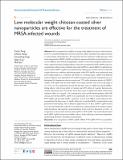Low molecular weight chitosan-coated silver nanoparticles are effective for the treatment of MRSA-infected wounds

View/
Author
Peng, Yinbo
Song, Chenlu
Yang, Chuanfeng
Guo, Qige
Yao, Min
Published Version
https://doi.org/10.2147/IJN.S122357Metadata
Show full item recordCitation
Peng, Yinbo, Chenlu Song, Chuanfeng Yang, Qige Guo, and Min Yao. 2017. “Low molecular weight chitosan-coated silver nanoparticles are effective for the treatment of MRSA-infected wounds.” International Journal of Nanomedicine 12 (1): 295-304. doi:10.2147/IJN.S122357. http://dx.doi.org/10.2147/IJN.S122357.Abstract
Silver nanoparticles (AgNPs) are being widely applied as topical wound materials; however, accumulated deposition of silver in the liver, spleen, and other main organs may lead to organ damage and dysfunction. We report here that low molecular weight chitosan-coated silver nanoparticles (LMWC-AgNPs) are effective against methicillin-resistant Staphylococcus aureus (MRSA), have better biocompatibility, and have lower body absorption characteristics when compared with polyvinylpyrrolidone-coated silver nanoparticles (PVP-AgNPs) and silver nanoparticles without surface stabilizer (uncoated-AgNPs) in a dorsal MRSA wound infection mouse model. LMWC-AgNPs were synthesized by reducing silver nitrate with low molecular weight chitosan as a stabilizer and reducing agent, while PVP-AgNPs were synthesized using polyvinylpyrrolidone as a stabilizer and ethanol as a reducing agent. AgNPs with different surface stabilizers were identified by UV-visible absorption spectrometry, and particle size was determined by transmission electron microscopy. UV-visible absorption spectra of LMWC-AgNPs, PVP-AgNPs and uncoated-AgNPs were similar and their sizes were in the range of 10–30 nm. In vitro experiments showed that the three types of AgNPs had similar MRSA-killing effects, with obvious effect at 4 μg/mL and 100% effect at 8 μg/mL. Bacteriostatic annulus experiments also showed that all the three types of AgNPs had similar antibacterial inhibitory effect at 10 μg/mL. Cell counting kit-8 assay and Hoechst/propidium iodide (PI) staining showed that LMWC-AgNPs were significantly less toxic to human fibroblasts than PVP-AgNPs and uncoated-AgNPs. Treatment of mice with MRSA wound infection demonstrated that the three types of AgNPs effectively controlled MRSA wound infection and promoted wound healing. After continuous application for 14 days, LMWC-AgNPs-treated mice showed significantly reduced liver dysfunction as demonstrated by the reduced alanine aminotransferase and aspartate aminotransferase levels and liver deposition of silver, in comparison to mice treated with uncoated-AgNPs or PVP-AgNPs. Our results demonstrated that LMWC-AgNPs had good anti-MRSA effects, while harboring a better biocompatibility and lowering the body’s absorption characteristics.Other Sources
http://www.ncbi.nlm.nih.gov/pmc/articles/PMC5221798/pdf/Terms of Use
This article is made available under the terms and conditions applicable to Other Posted Material, as set forth at http://nrs.harvard.edu/urn-3:HUL.InstRepos:dash.current.terms-of-use#LAACitable link to this page
http://nrs.harvard.edu/urn-3:HUL.InstRepos:30371002
Collections
- HMS Scholarly Articles [17922]
Contact administrator regarding this item (to report mistakes or request changes)

